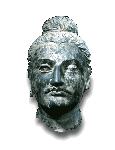
|
ARH 382 |

|
ARH 382 |
 |
>> | ID Lists | >> | ID List 14 |
Erdeni-Zu – Buddhist lamasery located by the site of Karakorum (“the black city”), the capital of the Mongol Empire. Of more than 700 monasteries in Mongolia at the beginning of the 20th c., Erdeni-zu was one of five monasteries to survive the period of Socialism. Priestly Personages
- Milarepa (1040 – 1123 CE) – First Tibetan to reach enlightenment during one lifetime; great poet and teacher.
- Padmasambhava – An Indian monk, called to Tibet by the reigning king in order to strengthen Buddhism.
Buddhism - Tantric
- Amitabha – Lit. “immortal or of immeasurable life-span.” the fourth Jina (“celestial Buddha”) who corresponds to Sakyamuni Buddha, the historical Buddha and the cardinal direction of the West.
- Mahakala – Lit. “the great black one.” He is the destructive form of the Hindu god Siva, adapted into Tantric Buddhism. In Tibet, Mahakala is a Dharmapala (protector of the teachings.). In his Mongolian form, he is the protector of the tent.
- Paramasukha-Chakrasamvara – Lit. “supreme bliss wheel of incarnation.” He is the emanation of Aksobhya (the second Jina, the imperturbable one, whose cardinal direction is East). Vajravarahi is his consort.
- Taras – White, Green and Black – Female emanations of Avalokitesvara
- Vajrakumara – Lit. “young prince of the thunderbolt.” He is the metamorphized body of Amitabha.
- Vajrasattva – Lit. “bodhissattva of the thunderbolt.” He is an emanation of Vairocana, the guardian of the North. His consort is Ghantapani.
- Yamantaka – He is the destroyer of death who is an emanation of Amitabha; he is usually shown wearing the buffalo head of Yama, the Lord of Death.
Buddhist Art - Mongolia
- Chorten – the specific Tibetan form of the Buddhist stupa
- Zanabazar (1594 – 1655 CE) – Mongolian Buddhist monk and accomplished writer, thinker, and artist.
|